Landmine Monitor 2019
Casualties
Overview
Antipersonnel and antivehicle landmines, including improvised landmine types, unexploded cluster submunitions,[1] and other explosive remnants of war (ERW)—henceforth mines/ERW—remain a significant threat and continue to cause indiscriminate harm.
Following a sharp rise in casualties due to increased conflict and contamination in 2015, high numbers of casualties continued to be recorded in 2018. A total of at least 6,897 people were killed or injured by mines/ERW in the calendar year. Of that total, at least 3,059 people were killed, and another 3,837 people were injured; for one casualty it was not known if the person survived or was killed.[2]
Although the 2018 total was less than those of the three previous years, it was still almost double the lowest determined annual number of 3,457 casualties in 2013.
It is certain that numerous casualties went unrecorded. Some of the most mine/ERW-affected countries do not have national casualty surveillance systems in place, nor do other forms of adequate reporting exist. In some conflict-affected counties combined numbers were reported without the granularity of data needed so that it can be adequately disaggregated and used.
For the third consecutive year, in 2018, the highest number of annual casualties was caused by improvised mines (3,789). This was also the year with the most improvised mine casualties recorded to date.
Civilians represented the majority of casualties compared to military and security forces,[3] continuing the well-established trend of civilian harm that influenced the adoption of the Mine Ban Treaty: 71% of casualties were civilians in 2018 where the status was known. This represented a decrease in the percentage of civilian casualties from 87% in 2017 and around 80% in recent years.[4]
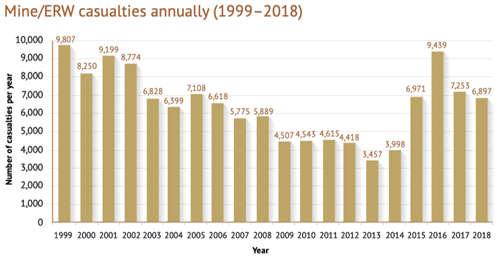
In 1999, on average there was more than one mine/ERW casualty occurring each hour.[5] In 2014, at the time of the Maputo Action Plan, the casualty total had dropped significantly and the Monitor recorded an average of about 10 casualties per day. However, in 2018, the rate was nearly double that, at just below 20 casualties per day.
Since the first years of the Mine Ban Treaty, it was certain that many casualties went unrecorded. In 1999, the Monitor identified some 9,000 casualties, but country estimates indicated that there were another 7,000–13,000 annual casualties that were not recorded in the available data. From 1999 through 2006, the number of new mine casualties (recorded and estimated calculated together) each year was between 15,000 and 20,000. For each year between 2009 and 2014, the Monitor estimated that there have been approximately 1,000 additional casualties (in the range of an additional 20–30% of the recorded total) that are not captured in its global mine/ERW casualty statistics. Subsequently, due to the highly irregular accessibility of data for countries experiencing conflict after 2014, estimating the gaps has become less feasible, even where some country estimates are available.
The global casualties total since 1999 has increased every reporting year due to new casualties recorded and also to the updating of historical data with newly available statistics. More than 130,000 casualties have been recorded by Landmine Monitor just in the period since 1999.[6]

The significant increase in recorded casualties since 2014 is primarily due to large numbers of casualties in relatively few countries with intensive armed conflict—including Afghanistan, Libya, Nigeria, Syria, and Ukraine, as well as Myanmar. However, there is a clear overall trend of declining casualty numbers in most countries since the Mine Ban Treaty entered into force in 1999. This includes large reductions in casualties from the worst peak years in Cambodia (1,153 casualties in 1999) and Colombia (1,229 casualties in 2006).
Countries with high and increasing numbers of casualties are mostly those with improvised mine casualties. In Monitor casualty reporting, the term “improvised mines” is synonymous with victim-activated improvised explosive devices (IEDs). IEDs are “homemade” explosive weapons that are designed to cause death or injury. Improvised mines are victim-activated IEDs that are detonated by the presence, proximity, or contact of a person or a vehicle. These are sometimes referred to as artisanal mines, victim-operated IEDs (VO-IEDs), and booby-traps or are described by the type of construction or initiation system, such as pressure-plate IEDs (PP-IEDs) and crush-wire IEDs. Improvised antipersonnel mines that are detonated by the presence, proximity, or contact of a person are prohibited by the Mine Ban Treaty.
The most improvised mine casualties recorded to date (3,789) was in 2018. To put the impact of this manifestation into perspective: for 2018, the number of improvised mine casualties alone was higher than the total number of casualties caused by all mine varieties (including improvised mines and all various unexploded ordnance) in the year with the least recorded casualties (3,475 in 2013).
Since 2005, the country with the most recorded improvised mine casualties each year has also had the greatest number of total annual casualties. In 2018, Afghanistan had the most recorded improvised mine casualties of all countries (1,586), followed by Syria (1,076). For the entire period since 1999, the greatest number of improvised mine casualties were recorded in Colombia (10,428), followed by Afghanistan (8,422).
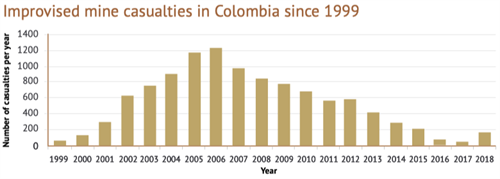
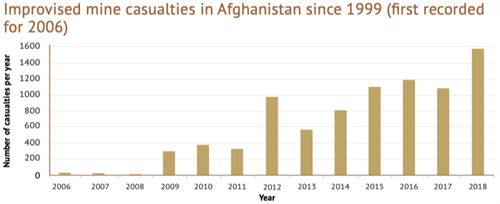
Casualties in 2018
The country with the most recorded total casualties in 2018 was State Party Afghanistan, with 2,234, followed by state not party Syria, with 1,465 casualties reported. Mine/ERW casualties were identified in a total of 50 states and other areas in 2018.[7]
Of the total recorded casualties in 2018, two-thirds (4,543 or 66%) occurred in 32 States Parties to the Mine Ban Treaty.[8]
Casualty Recording for 2018
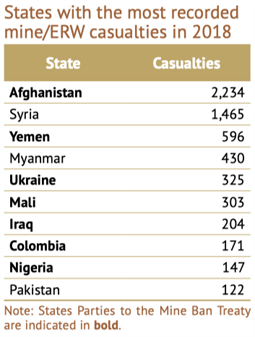
The 6,897 mine/ERW casualties identified in 2018 only include recorded casualties, not estimates of casualties.[9] It is certain that there are additional casualties each year that are not captured in the Monitor’s global mine/ERW casualty statistics, with most occurring in severely affected countries and those experiencing conflict. In some states and areas, numerous casualties go unrecorded; therefore, the true casualty figure is likely significantly higher in those countries.
In Afghanistan, data collection was affected by conflict and coverage declined due to the national Red Crescent Society no longer conducting casualty survey. Reporting of military casualties was generally rare in past years. After May 2017, the Afghan military stopped releasing its conflict casualty figures completely. However, more armed forces and non-state armed group (NSAG) casualties were recorded by the Monitor in 2018 than in previous years from other sources.[10] Monitor casualty data for 2018 includes 1,435 casualties recorded by Afghanistan’s Directorate of Mine Action Coordination (DMAC) and another 799, mostly military casualties, from analysis of casualties documented in the Armed Conflict Location and Event Data project (ACLED) compilation of media coverage of conflict incidents.[11] The United Nations Assistance Mission in Afghanistan (UNAMA) reported attributing an increase in mine/ERW casualty numbers in 2018 “to ‘new contamination’ by anti-personnel weapons in the country, linked to intensifying conflict.”[12]
The Monitor identified 1,465 mine/ERW casualties in Syria from multiple sources for 2018, which is a decrease from 1,906 in 2017.[13] However, since the conflict began in 2011, annual totals of recorded mine/ERW casualties are thought to be an undercount. Casualty totals have fluctuated in part due to inconsistent availability of data and sources. There are many people recorded as dead compared to those injured. Therefore, it is certain, based on the probable proportion of fatalities to people injured, that the actual number of casualties occurring in Syria in 2018, as in past years, was substantially higher than the annual total recorded.[14]
The ongoing conflict in Yemen prevented the effective operation of a national casualty surveillance mechanism. Yemen reported that the Yemen Executive Mine Action Center (YEMAC) information management system has become outdated and is currently not usable. Furthermore, the conflict has presented new mines and mine-technologies (improvised mines), with which YEMAC has had no previous experience. This is compounded by the scale of the conflict and its extensive impact geographically in the country.[15]
The figures reported for mine/ERW casualties in Yemen differ widely, underlining the abovementioned challenge of collecting reliable data in a context of ongoing conflict. In both its Article 5 extension request and its Mine Ban Treaty Article 7 Report for 2018, Yemen informed States Parties of 1,087 casualties recorded in 2018 (967 men and 120 women), without noting the number of persons killed and injured or types of explosive items causing casualty incidents.[16] The UN Humanitarian Response reporting observed that landmines caused the third most civilian casualties in 2018 in Yemen, despite a lower rate of incidents; reporting that 233 civilian casualties were the result of landmine incidents.[17] Other UN reporting stated that mines/ERW caused 227 child casualties alone in Yemen in 2018.[18] The Monitor total for 2018 is from multiple combined sources including other detailed data from YEMAC.
In Iraq, as in previous years, it is certain that there were many more mine/ERW casualties that occurred in 2018 that have not been identified. However, UN reporting indicates that there was a significant overall reduction in conflict-related casualties of all types, which may signal that the decrease in mine/ERW casualties since the reduction of recent conflict is part of a trend.[19]
Casualty data in Libya was not complete or comprehensive. It lacked key details, and data from 2018 was reportedly not yet entered into the national information management system.[20]
New information on casualties in Nigeria from 2016 through 2019 was recorded by Mines Advisory Group (MAG), which significantly heightened understanding and awareness of the extent of the impact of mines/ERW, especially improvised mines, in that State Party.
Casualty demographics[21]
There were at least 1,714 child casualties in 2018, which accounted for 40% of all casualties for whom the age group was known (4,310), but made up over half (54%) of civilians for whom the age group was known (3,088).[22] Children were killed (582) or injured (1,132) by mines/ERW in 38 states and other areas in 2018.[23] As in previous years, in 2018, the vast majority of child casualties where the sex was known were boys (84%).[24] ERW caused most child casualties (871, or 51%).
In 2018, men and boys made up the vast majority of all casualties, with 88% of all casualties for which the sex was known (4,162 of 4,709). Women and girls made up 12% of all casualties for which the sex was known (547).
Civilians represented 71% of casualties in 2018 where the civilian/military/deminer status was known (4,087 of 5,770); with 1,663 military casualties.[25] The country with the most recorded military casualties of mines/ERW in 2018 was Afghanistan (642); followed by Syria (269), both with state soldiers and NSAG combatant casualties (including militia) recorded; and Mali (153) with national and international military (including peacekeeper forces). The total military casualties for 2018 represented the second highest number recorded other than 2008 (1,694) in any year since 1999.
In 2018, the Monitor identified 20 casualties among deminers in seven countries (four deminers were killed and 16 injured).[26] Another 28 casualties (26 killed and two injured) were state military and NSAG personnel who were killed and injured while clearing, disarming, or dismantling mines in Syria. These were not included in the total of deminer casualties.[27]
Mine/ERW types resulting in casualties
Monitor casualty records include only mine/ERW casualties; people killed or injured in incidents involving explosive items detonated by the presence, proximity, or contact of a person or vehicle.[28] Casualties from incidents caused or reasonably suspected to have been caused by remotely detonated mines or IEDs—those that were not victim-activated—are not included. Mines/ERW therefore differs from the classification of explosive ordnance.[29] That is because the definition of explosive ordnance additionally includes devices that are activated manually or by remote control.[30] In practical terms for casualties reporting in 2018, for example, some 427 casualties of landmines or IEDs in Yemen, which were not clearly victim-activated, were excluded from the global dataset, as were hundreds of casualties recorded in Libya, Pakistan, Syria, and other countries impacted by improvised mines and emplaced IEDs.
In 2018, landmines of all types caused at least 4,885 casualties—these were recorded as being caused by factory-made antipersonnel mines (332), improvised mines (3,789), antivehicle mines (394), and other unspecified mine types (370).
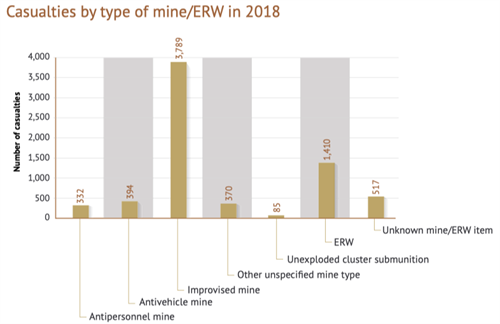
As noted previously, improvised mines that can be detonated by the presence, proximity, or contact of a person, fit the definition of antipersonnel mines and are therefore prohibited under the Mine Ban Treaty. Of the total 3,789 improvised mine casualties recorded for 2018, at least 1,752 (46%) were reported specifically to be “antipersonnel mines” of an improvised nature.[31] Only 204 (5%) of the total improvised mine casualties for 2018 (those recorded for Mali), were believed to be certain to act as “antivehicle mines”. The rest were not recorded specifically as to the mine type as the exact nature of the trigger mechanisms of improvised mines is often not reported in many countries; however, available information indicates that the fusing of most improvised mines causing casualties worldwide allows them to be activated by a person, thus effectively making them prohibited under the Mine Ban Treaty. For example, in Colombia antipersonnel mines are all of an improvised nature and in Ukraine most improvised antipersonnel mines recorded were tripwire-fitted hand grenades. In June 2019, UNAMA stated that it “reiterates that victim-activated pressure plate IEDs [a common type of improvised mines in many countries] function like anti-personnel landmines, which are prohibited under the Ottawa Convention on Anti-Personnel Mines.”[32]
Casualties from improvised mines were identified in 18 states in 2018.[33] Most improvised mine casualties in 2018 occurred in Afghanistan (1,586) and Syria (1,076). Casualties recorded as caused by factory-made antipersonnel mines (thus, not including improvised mines) were documented in 19 states and areas in 2018, four less than in 2017.[34]
In 2018, antivehicle mines were recorded as having caused at least 394 casualties in 20 states and areas.[35] The states with the greatest numbers of casualties reported from antivehicle mines were Yemen (154) and Mali (98).[36] In both countries, factory-made antivehicle mines are also used in the construction of improvised mines, making it difficult to distinguish between these types from reporting, or disaggregate casualties by the explosive item responsible with a high level of certainty. Often, such modifications may make the mine effectively an antipersonnel device, because it can be triggered by a person. For example, it was claimed that Houthi (Ansar Allah) forces refitted antivehicle mines that originally required 100kgs of pressure to trigger a detonation, so that they could explode with a force of just 10kgs.[37] Such modification often involves the addition of mechanisms to detonate the mines such as pressure plates or tripwires, which also increase the area coverage as well as the sensitivity of fusing.
In Mali, only vehicles were involved in mine incidents recorded in 2018 and no casualties occurred while individuals were on foot, though 25 of the civilian casualties in Mali in 2018 occurred in 10 incidents where they were on an animal-drawn cart.
Another 370 casualties were recorded under the category of other unspecified mine types in 18 states and areas.[38]
Unexploded submunitions caused 85 casualties.[39] Where the age group was known (59), child casualties made up more than half (39, or 66%) of all casualties caused by unexploded cluster submunitions.
Casualties caused by ERW numbered 1,410 in 32 states and areas in 2018.[40] Of the annual total, 632 ERW casualties occurred in Afghanistan. In 2018, globally, children made up 69% (871) of ERW casualties, when the age group was recorded.
In 2018, a total of 517 casualties were the result of mine/ERW items that were either not specifically identified initially, were otherwise undifferentiated or remained unknown during casualty recording (such as hospital records), or were not disaggregated when recorded in data systems.[41]

ANNEX

[1] Casualties from cluster munition remnants are included in the Monitor global mine/ERW casualty data. Casualties occurring during a cluster munition attack are not included in this data; however, they are reported in the annual Cluster Munition Monitor report. For more information on casualties caused by cluster munitions see, ICBL-CMC, Cluster Munition Monitor 2015, www.the-monitor.org/CMM2015/VictimAssistance.
[2] As in previous years, there was no substantial data available on the numbers of people indirectly impacted as a result of mine/ERW casualties and this information was not included in the Monitor mine/ERW casualty database.
[3] The category “military” includes police forces and private security forces when active in combat as well as members of non-state armed groups and militias. Direct participation in armed conflict, also called direct participation in hostilities, distinguishes persons who are not civilians in accordance with international humanitarian law, whereby “those involved in the fighting must make a basic distinction between combatants, who may be lawfully attacked, and civilians, who are protected against attack unless and for such time as they directly participate in hostilities.” ICRC, “Direct participation in hostilities: questions & answers,” 2 June 2009, bit.ly/ICRCDirectParticipationFAQ.
[4] Civilian casualties were recorded at 70% both in 2011 and 2009.
[5] In 1999, the Monitor originally identified 9,220 mine/ERW casualties.
[6] The Monitor database includes 130,755 casualties for the period 1999–2018.
[7] In 2018, casualties were recorded in Afghanistan, Algeria, Angola, Armenia, Azerbaijan, Bangladesh, Bosnia and Herzegovina (BiH), Cambodia, Cameroon, Chad, China, Colombia, Democratic Republic of Congo (DRC), Egypt, Ethiopia, India, Iran, Iraq, Israel, Kenya, Kuwait, Lao PDR, Lebanon, Libya, Mali, Mauritania, Morocco, Mozambique, Myanmar, Niger, Nigeria, Pakistan, Palestine, Philippines, Senegal, Somalia, South Sudan, Sudan, Syria, Tajikistan, Thailand, Tunisia, Turkey, Ukraine, Vietnam, Yemen, Zimbabwe, and three other areas Nagorno-Karabakh, Somaliland, and Western Sahara.
[8] Casualties were identified in the following States Parties in 2018: Afghanistan, Algeria, Angola, Bangladesh, BiH, Cambodia, Cameroon, Chad, Colombia, DRC, Ethiopia, Iraq, Kenya, Kuwait, Mali, Mauritania, Mozambique, Niger, Nigeria, Palestine, Philippines, Senegal, Somalia, South Sudan, Sudan, Tajikistan, Thailand, Tunisia, Turkey, Ukraine, Yemen, and Zimbabwe.
[9] The data collected by the Monitor is the most comprehensive and widely-used annual, and global, dataset of casualties caused by mines/ERW. The casualty total for 2018 included datasets or reporting from the following types of sources: international organizations, conflict tracking databases, UN and national mine action centers, other UN agencies, humanitarian mine action operators, ICBL members, and other NGOs, as well as media scanning.
[10] Additionally, in 2018 the Monitor again began including casualties among NSAG forces emplacing improvised mines. These had previously been excluded due to the likelihood that the emplaced explosive item causing the accidental explosion was a command-denotated IED. However, by 2018, there was less distinction between incidents of NSAGs as casualties of their own minefields or laying the improvised mines, and more indications that accidents involved laying trigger-sensitive improvised mines.
[11] Monitor analysis of Armed Conflict Location and Event Data project (ACLED) data for calendar year 2018. Approved citation: Clionadh Raleigh, Andrew Linke, Håvard Hegre, and Joakim Karlsen, “Introducing ACLED-Armed Conflict Location and Event Data,” Journal of Peace Research, Issue 47(5), 2010, pp. 651–660.
[12] “Rising landmine blast toll in Afghanistan highlights long-term care needs of survivors,” UN News, 6 February 2019, https://news.un.org/en/story/2019/02/1032141.
[13] Not including the occupied Golan Heights.
[14] The Monitor recorded 933 people killed and 532 people injured in Syria in 2018, whereas generally only just over a quarter of all mine/ERW casualties will be fatalities.
[15] Yemen, Mine Ban Treaty Article 5 deadline Extension Request, 2019, p. 9.
[16] Ibid.; and Mine Ban Treaty Article 7 Report (for calendar year 2018).
[17] United Nations High Commissioner for Refugees, “Civilian Impact Monitoring Report: January–December 2018,” p. 9, http://bit.ly/369Zmaw.
[18] UN Security Council, “Report of the Secretary-General, Protection of civilians in armed conflict,” 7 May 2019, para. 31, http://bit.ly/36be2Gs; and UN, “Inter-agency messaging for the Vienna Conference on Protecting Civilians in Urban Warfare,” 3 October 2019.
[19] In December 2018, UN Assistance Mission for Iraq (UNAMI) reported that its “monitoring in recent months has shown a steady reduction in civilian casualties.” UNAMI decided to stop releasing civilian casualty updates on a monthly basis, but rather based on the circumstances.
[20] Audrey Torrecilla, “Victim Assistance in Libya Position Paper,” UNMAS Libya, September 2019, pp. 23–27, www.unmas.org/sites/default/files/va_report_libya_2019-libmac-unmas.pdf.
[21] The Monitor tracks the age, sex, civilian status, and deminer status of mine/ERW casualties to the extent that data is available and disaggregated.
[22] Child casualties are defined as all casualties where the victim is less than 18 years of age at the time of the incident.
[23] In 2018, child casualties were recorded in Afghanistan, Algeria, Angola, Azerbaijan, Bangladesh, Cambodia, Chad, Colombia, DRC, Egypt, Ethiopia, India, Iran, Iraq, Kenya, Lao PDR, Lebanon, Libya, Mali, Mozambique, Niger, Nigeria, Pakistan, Palestine, Philippines, Senegal, Somalia, South Sudan, Sudan, Syria, Tunisia, Turkey, Ukraine, Vietnam, Yemen, Zimbabwe, and two other areas, Somaliland and Nagorno-Karabakh.
[24] There were 1,163 boys and 231 girls recorded as casualties in 2018; the sex of 320 child casualties was not recorded.
[25] In 2018, military casualties were recorded in Afghanistan, Algeria, Cameroon, Chad, Colombia, India, Iran, Iraq, Libya, Mali, Morocco, Niger, Nigeria, Pakistan, Tunisia, Turkey, Ukraine, Yemen, and other area Western Sahara.
[26] In 2018, casualties among deminers occurred in Afghanistan, China, Iran, Libya, South Sudan, Syria, Turkey, and Yemen.
[27] Also, a demining dog was killed in a mine explosion in Turkey.
[28] Such as all antipersonnel mines, antivehicle mines, abandoned explosive ordnance (AXO), unexploded ordnance (UXO), and improvised mines (victim-activated IEDs.) AXO and UXO are collectively referred to as ERW. Cluster munition casualties are disaggregated and reported as distinct from ERW casualties. Not included in the totals are estimates of casualties where exact numbers were not given.
[29] International Mine Action Standards 04.10, “Glossary of mine action terms, definitions and abbreviations” says 3.99. Explosive Ordnance (EO) (2018) “interpreted as encompassing mine action’s response to the following munitions: Mines, Cluster Munitions, Unexploded Ordnance, Abandoned Ordnance, Booby traps, Other devices (as defined by CCW APII), Improvised Explosive Devices.” Convention on Conventional Weapons Amended Protocol II, Article 2 - Definitions: ‘Other devices’ include “improvised explosive devices which are activated manually, by remote control or automatically after a lapse of time.”
[30] See the table in the Annex of this section.
[31] The total of improvised antipersonnel mine casualties recorded in 2018 in Afghanistan (1,586), Colombia (150), and Ukraine (16).
[32] UNAMA, “Midyear Update on The Protection of Civilians in Armed Conflict: 1 January to 30 June 2019,” 30 July 2019, p. 6, http://bit.ly/2BPTBRa.
[33] Not included among casualties recorded from factory-made antipersonnel mines, antivehicle mines, or other unspecified types of mines. Casualties from improvised mines in 2018 occurred in Afghanistan, Algeria, Bangladesh, Colombia, India, Iraq, Israel, Libya, Mali, Niger, Nigeria, Pakistan, Syria, Thailand, Tunisia, Turkey, Ukraine, and Yemen. Additionally, improvised mine casualties were known to have occurred in Myanmar, but these are undifferentiated from other mine casualties in data. Among sources used by the Monitor for calendar year 2018 data on improvised mine casualties, data from among the casualties of explosive incidents categorized as “victim-activated” in the Action on Armed Violence (AOAV) explosive violence data set for 2018 was included. AOAV casualty data for 2018, provided by email from Jennifer Dathan, Researcher, AOAV, 15 March 2019; and Monitor analysis of Armed Conflict Location and Event Data project (ACLED) data for calendar year 2018. Approved citation: Clionadh Raleigh, Andrew Linke, Håvard Hegre, and Joakim Karlsen, “Introducing ACLED-Armed Conflict Location and Event Data,” Journal of Peace Research, Issue 47(5), 2010, pp. 651–660.
[34] In 2018, antipersonnel mine casualties were recorded in Afghanistan, Algeria, Angola, Azerbaijan, BiH, Cambodia, India, Iran, Iraq, Lebanon, Libya, Myanmar, Pakistan, Tajikistan, Thailand, Turkey, Ukraine, Zimbabwe, and other area Western Sahara.
[35] In 2018, casualties from antivehicle mines were identified in the following states: Afghanistan, Angola, Armenia, Cambodia, Chad, Egypt, Ethiopia, Israel, Kuwait, Libya, Mali, Mauritania, Morocco, Myanmar, Pakistan, Ukraine, Yemen, and other areas, Nagorno-Karabakh, Somaliland, and Western Sahara.
[36] The Monitor shares, cross-references, and compares data with the Geneva International Centre for Humanitarian Demining (GICHD) and the Stockholm International Peace Research Institute (SIPRI) Anti-vehicle mines (AVM) project. That project recorded 569 casualties from both confirmed and suspected antivehicle mines in 2018. GICHD-SIPRI casualty data provided by email from Ursign Hofmann, Policy Advisor, GICHD, 25 June 2019; and GICHD-SIPRI, “The humanitarian and developmental impact of anti-vehicle mines: Global mapping and analysis of anti-vehicle mine incidents in 2018,” 2019, www.sipri.org/sites/default/files/2019-08/avm-incident-report-2018.pdf. Monitor and GICHD-SIPRI methodologies used to enter data differ, resulting in the differences in annual casualties reported. The research scope of the AVM project was broadened in 2018, in order to better record incidents caused by antivehicle mines of an improvised nature. However, in Monitor reporting when an incident was attributed to both antivehicle mines and improvised mines in different sources, the Monitor sometimes included those as improvised mine casualties. Monitor reporting does include politically disputed geographic “other areas” in reporting, and tends to use the definitions employed in original whole data sets when possible.
[37] Project Masam: Saudi project for demining in Yemen, “Landmines are the gift of death to the Yemenis,” undated, www.projectmasam.com/eng/landmines-are-the-gift-of-death-to-the-yemenis.
[38] In 2018, unspecified mine casualties were recorded in Algeria, Armenia, Bangladesh, Cameroon, Chad, Egypt, India, Iran, Iraq, Libya, Niger, Philippines, Somalia, Syria, Tunisia, Turkey, Ukraine, and other area Western Sahara.
[39] In 2018, unexploded submunition casualties were recorded in Afghanistan, Iraq, Lao PDR, Lebanon, South Sudan, Syria, Ukraine, Yemen, and other area Nagorno Karabakh. One additional casualty for Iraq was identified after Cluster Munition Monitor 2019 was published. For more information on casualties caused by unexploded submunitions and the annual increase in those casualties recorded for the year 2018, see ICBL-CMC, Cluster Munition Monitor 2019.
[40] In 2018, ERW casualties were recorded in Afghanistan, Angola, Cambodia, Chad, Colombia, DRC, Egypt, Ethiopia, India, Iran, Iraq, Kenya, Lao PDR, Libya, Mali, Myanmar, Nigeria, Pakistan, Palestine, Philippines, Senegal, Somalia, South Sudan, Sudan, Syria, Turkey, Ukraine, Vietnam, Yemen, and other areas Nagorno-Karabakh, Somaliland, and Western Sahara.
[41] Casualties from unknown mine/ERW items were recorded in: Angola, China, India, Iran, Iraq, Lebanon, Libya, Mozambique, Myanmar, Nigeria, Somalia, South Sudan, Sudan, Syria, Turkey, Ukraine, and Vietnam.

